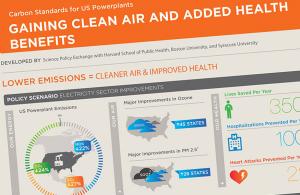Let's Have Full Disclosure on Harvard's New Health Study

As the saying goes, you get what you pay for.
That's the lesson one might well draw from the remarkable but yet not so surprising coincidences that have emerged regarding (A) the U.S. Environmental Protection Agency (EPA) and its "Clean Power Plan" to reduce carbon emissions from existing coal-fired power plants, and (B) an academic study released two months ago by some half-dozen PH.D's from Harvard, Syracuse University, and other schools and NGOs that purports to justify the CPP.
That's because the Study, in analyzing the merits of three different alternative options for mitigating climate change - (1) a carbon tax, (2) upgrading coal plants, or (3) a holistic (outside the fence) strategy that includes improving energy efficiency for electricity users - found that the best and most convincing chance to maximize health benefits across the nation comes would come from option 3, the program that most resembles the plan advocated by EPA: the very same EPA that has supplied some $45 million in to scholars who participated in the Study.
The newly released health study has provoked a sharp divide between advocates and contrarians on either side of EPA's Clean Power Plan. On one hand, no one in the major media has questioned the Study's claims. On the other hand, the contrarians just want full disclosure from all the relevant parties.
And on behalf of the loyal opposition, it seems a perfect time to ask a basic question about whether the EPA's Clean Power Plan passes the same test of "necessary and appropriate." Ultimately, does the Supreme Court have all of the relevant facts, including the Harvard Health Study's objectivity, to decide on the CPP's constitutionality?
As the EPA gets closer to issuing its final set of regulations for the Clean Power Plan, the feeling prevails among most observers that CPP is a fait accompli, offering little or no room for the loyal opposition to present its case on the urgency of climate change mitigation, the cost of early action, the ability of scientists to predict 85 years into the future, the funding bias of Study, and the overall benefits of EPA's plan.
First, a little background. Consider the following top-ten list: a litany of key events - working backward in time from this summer - on the current battle over the Clean Power Plan and the controversy surrounding the Harvard Health Study, headed up by Dr. Charles Driscoll, University Professor of Environmental Systems Engineering at Syracuse University, and published recently in the journal Nature Climate Change, under the title, "Clean Air and Health Co-Benefits of U.S. Power Plant Carbon Standards":
- EPA's Next Step. In August, the EPA is prepared to release its final regulations using the Driscoll study's result as a predicate to highlight the need for the EPA to take jurisdiction over the entire electrical grid on the U.S;
- Mercury and the Court. The basis for the Supreme Court's June 29, 2015, MATS ruling says that costs for implementing EPA's related rule on "mercury and air toxics" from coal-fired power plants will total almost $10 billion, while yielding only about $4-6 million in immediate health benefits;
- Funding Grants. The scholars who participated in the Study have already received $45 million in grants from the EPA;
- Costs and Benefits. The Study is said both to confirm the EPA's "health benefits" analysis for its Clean Power Plan (or as EPA spokesman Liz Puchia put it, "this new study supports the EPA findings"), and also to suggest perhaps that EPA may have underestimated the costs of producing those health benefits;
- Objectivity. The Study's co-authors say they have maintained objectivity: Charles Driscoll of Syracuse told the Buffalo News that he had "no dog in this fight" and Jonathan Buonocore of Harvard told the U.S. News and World Report that the EPA did not participate in the study or interact with the authors;
- Smoking Gun Emails? Almost a 100 pages of emails passed between the EPA and the Driscoll Harvard health study group, starting on July 8, 2014, and extending at least until May 22, 2015;
- The Audacity of EPA. The EPA's Clean Power Plan, its comprehensive but controversial proposed rule on reducing carbon emissions from coal-fired power plants, is announced on June 2, 2014;
- An Early EPA Victory. The U.S. Court of Appeals for the D.C. Circuit rules April 15, 2014, in favor of the EPA MATS' regulation;
- Evidence Goes Missing. On April 11, 2014, the EPA concedes to the House Science, Space and Technology Committee of the House of Representative that they do not have nor can produce all the data the EPA used in justifying its MATS or Clean Air rules;
- A Modest Beginning. The EPA first formulates its MATS regulations in 2011.
Certainly, the CPP has become an enormous political football, with the line drawn between the EPA and its environmental backers versus the CPP's opponents. In fact, the White House recently completed its Climate Change Impacts and Risks Analysis (CIRA), which spans 20 U.S. sectors related to health, infrastructure, electricity, water resources, agriculture and forestry and ecosystems, and which claims that the Clean Power Plan with save 57,000 lives a year and several $ trillion by 2100.
Also, in response to the recent Supreme Court ruling on EPA's mercury rule, the EPA's Gina McCarthy has been a highly visible advocate of the plan, appearing recently with Bill Maher's Topline, Georgetown's Discussion on Pope Francis' Encyclical and Environment, a CNN interview with John Sutter, George Mason University's Washington Youth Summit, plus an NPR interview with Melissa Block, to name a few.
It is quite likely that the Supreme Court and the entire utility industry - including state public utility commissions, federal energy agencies like the U.S. Federal Energy Regulatory Commission (FERC), state and federal elected officials, and utility companies (including those who own only the transmission lines) - would be much more comfortable with such sweeping and new regulations as contemplated by EPA if only there were full disclosure and an absence of funding bias of all elements, financial and otherwise, that went into the costs and benefits analysis used by the EPA, when it wrote the Clean Power Plan regulations.
Clearly, the Supreme Court needs to know all pertinent information before it makes its constitutional ruling on the EPA's Clean Power Plan.
Stephen Heins is an energy and regulator consultant for a Wall Street firm. Previously, Heins was Vice President of Corporate Communication for Orion Energy Systems, a publicly-traded leader in innovating energy and lighting systems based in Manitowoc, Wis.
Lead art comes from http://news.harvard.edu/gazette/story/2015/05/benefits-of-clean-power-plan-are-clear/




